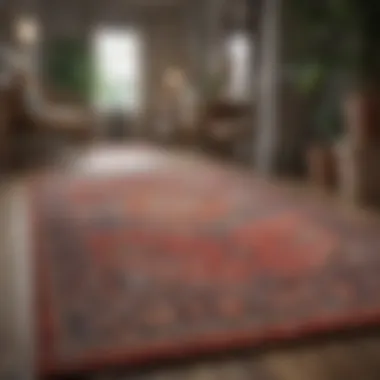Explore Quality Rug Stores for Your Home


Intro
Selecting a rug store is more than just a shopping task. It can greatly impact the aesthetics and comfort of any space. Rugs serve both functional and decorative purposes, often tying together the overall design of a room. Thus, making a well-informed decision about where to buy rugs is essential. This guide provides insights into different types of rugs, what features to look for in a store, and pragmatic tips for a successful purchase journey.
In today’s market, consumers encounter a wide array of options, from luxurious handmade pieces to eco-friendly alternatives. Understanding these various types can enhance the rug-buying experience. Additionally, recognizing what makes a retailer reputable will also play a crucial role. Economic factors and sustainability are becoming increasingly important in this industry. Homeowners and design enthusiasts alike must consider these aspects to make choices that not only beautify their spaces but also align with their values.
This article serves as a comprehensive roadmap for anyone looking to elevate their living space with quality rugs, whether through online platforms or brick-and-mortar stores.
Prelude to Rug Stores
Rug stores play a crucial role in the landscape of interior design and home aesthetics. They provide not only a means to enhance a space but also serve as an important resource for homeowners looking to make informed choices. In this section, we explore the underpinning factors around rug stores and their significance.
Understanding the Importance of Rugs
Rugs are more than just decorative pieces placed on the floor. They have an undeniable impact on the overall ambiance of a room. When chosen thoughtfully, a rug can tie together various design elements, creating a cohesive look. The texture, color, and size contribute to the feel of a space. Moreover, rugs offer practical benefits, such as comfort and warmth underfoot. These pieces can also absorb sound, making a room feel quieter and more serene.
Notably, rugs can highlight a specific area, delineating spaces without the need for physical barriers. Their placement can influence both functionality and flow within a home, elevating everyday interactions. Thus, understanding the importance of rugs is essential for anyone looking to enhance their living space.
The Role of Rug Stores in Interior Design
Rug stores serve several key functions in the realm of interior design. They are not merely retail outlets; they are repositories of inspiration and guidance. These establishments allow customers to observe a broad selection of styles and materials. Whether one is drawn to classic Persian patterns or sleek, modern designs, the store's offerings can inform and refine personal taste.
Additionally, knowledgeable staff help to guide buyers through their options. They provide insights on different rug materials, care instructions, and the suitability of rugs for various spaces. Recommendations from experienced professionals can prevent costly mistakes.
Moreover, many rug stores support customization. Homeowners can request specific sizes, colors, or patterns tailored to their needs. This presents an opportunity to imbue spaces with a personal touch, making the selection process not just a transaction, but a collaborative effort.
Types of Rugs Available
Understanding the variety of rugs is crucial when selecting the right one for your space. Each type offers distinct benefits and aesthetics, thus impacting the overall design and functionality of a room. Whether you prioritize comfort, style, or environmental considerations, recognizing these different categories will help tailor your choices to suit your needs effectively. Below, we will explore four primary types of rugs: traditional, modern, outdoor, and eco-friendly, discussing their unique characteristics and appropriate settings where they thrive.
Traditional Rugs
Traditional rugs often reflect the craftsmanship and heritage of specific cultures. They are typically handwoven, showcasing intricate designs and vibrant colors. Common materials include wool, silk, or cotton, which provide durability and comfort. These rugs add a sense of warmth and historic charm to spaces, making them ideal for formal or classic interiors.
When choosing a traditional rug, consider the motifs and colors present in your room. They work well in settings emphasizing elegance, such as dining rooms or living areas.
Key Characteristics of Traditional Rugs:
- Timeless designs that never go out of style
- High-quality craftsmanship
- Variety in styles, from Persian to Oriental
Modern Rugs
Modern rugs break away from conventional styles, often embracing minimalism and abstraction. They can be made from synthetic fibers, making them more affordable and versatile. Their designs are usually simpler, focusing on geometric shapes and solid colors.
These rugs are perfect for contemporary homes aiming for a sleek aesthetic. They are often utilized in spaces such as offices, modern living rooms or even as statement pieces in eclectic settings.


Benefits of Modern Rugs:
- Easy to clean, often machine-washable
- Diverse materials to choose from, including wool blends and synthetics
- Ideal for minimalistic or transitional decor
Outdoor Rugs
Outdoor rugs are designed to withstand exposure to the elements. They are made from durable, moisture-resistant materials like polypropylene. These rugs can add comfort to outdoor spaces such as patios, decks, or gardens while providing a defined area for seating or dining.
When selecting an outdoor rug, consider the climate in your area. Look for options that resist fading and mold to ensure longevity.
Important Features of Outdoor Rugs:
- Made from weather-resistant materials
- Easy to clean and dry quickly
- Comes in diverse styles that complement outdoor decor
Eco-Friendly Rugs
As sustainability becomes increasingly critical in design, eco-friendly rugs are gaining popularity. Made from natural fibers like jute, sisal, or organic cotton, these rugs not only reduce environmental impact but also appeal to conscious consumers. They usually feature simple designs that promote a rustic aesthetic.
These rugs are well-suited for homes that prioritize health and well-being, as they often do not contain harmful chemicals or dyes. They are perfect for living spaces aiming for a natural vibe.
Considerations When Choosing Eco-Friendly Rugs:
- Ensure certifications like GOTS (Global Organic Textile Standard)
- Look for biodegradable materials
- Support brands with transparent production practices
"Understanding the types of rugs available is integral in making an informed decision that matches your aesthetic and practical needs."
Selecting a Good Rug Store
Choosing the right rug store is crucial for anyone looking to enrich their living space. A good rug can enhance not just aesthetic appeal but also comfort and utility in a home. The right store should cater to diverse needs, ensuring that customers find exactly what they seek. Factors like product quality, customer service, variety, and online presence are essential in making an informed decision. Understanding these factors can lead to a rewarding shopping experience and ultimately, a rug that meets your design aspirations.
Factors to Consider When Choosing a Store
Quality of Products
The quality of products is perhaps the most significant aspect to consider. High-quality rugs are often made from durable materials, ensuring they withstand wear and tear over time. A rug that uses premium fibers such as wool or silk typically offers better texture, durability, and visual appeal. Customers benefit from investing in quality products as they require less frequent replacement. On the other hand, lower-quality rugs may appear appealing initially but fade or fray much quicker. Therefore, evaluating the craftsmanship and materials used is key for long-term satisfaction.
Customer Service Excellence
Customer service excellence directly influences the shopping experience. A store that values its customers will provide knowledgeable staff who can assist with questions and offer personalized recommendations. Good customer service creates a welcoming environment and builds trust. When you feel supported during your shopping, it makes the decision-making process easier. Conversely, poor service can lead to frustration and confusion about what to select. Prioritizing stores known for quality customer interactions can prevent unnecessary hassle during the rug buying journey.
Variety of Styles
The variety of styles offered by a rug store can significantly impact your selection process. A store with a wide range of styles can accommodate diverse tastes, ensuring that every individual can find something that suits their home. Whether seeking traditional Persian designs or contemporary abstract patterns, having options allows for better customization of your living space. A limited selection can constrain creativity and may result in dissatisfaction. It is beneficial to find a store that showcases multiple styles to meet various design preferences.
Online Presence and Reviews


The online presence and reviews of a rug store play a vital role in assessing its reputation and credibility. A strong online presence often indicates that a store is engaged with its customers and stays updated with trends. Customer reviews provide insights into the actual shopping experiences others have had, highlighting strengths or weaknesses of the store. Reading reviews can guide prospective buyers toward reputable retailers. However, always be cautious of overly positive reviews that may not reflect the reality of the shopping experience.
Reputable Online Rug Retailers
When considering rug purchases, several online retailers stand out due to their reputation and wide selection. Websites like Wayfair and Overstock are known for providing varied options at competitive prices. Additionally, stores like Ruggable offer unique washable rugs, appealing to those seeking practicality alongside aesthetics. Always examine shipping policies and return options before making a purchase. Ensuring a good return policy can safeguard against potential dissatisfaction with your choice.
Local vs Online Shopping for Rugs
Both local and online shopping have unique advantages and limitations. Local stores offer the chance to see and touch the rug before purchase, providing a tactile experience that online shopping cannot match. Seeing colors and textures in person often leads to more confident buying decisions. However, online shopping allows for a broader selection and often better prices. When deciding, assess your priorities; if you value immediate gratification and personal interaction, local stores may serve you best. Conversely, if you're driven by selection and price, online retailers may be a more fitting option.
Price Considerations in Rug Shopping
Price is a significant factor when selecting a rug. Understanding price considerations is crucial not only for budgeting but also for determining the value of your investment. Rugs often serve as focal points in a room, and the right choice can elevate the overall aesthetic and functionality of a space. Knowing the pricing structures helps consumers navigate their options effectively.
Understanding Pricing Structures
Rug pricing can vary widely based on several elements. The materials used, the technique of manufacturing, and the region of origin all contribute to differing price points.
- Material: Natural fibers like wool and silk usually have higher costs. In contrast, synthetic materials may be less expensive but can vary in quality.
- Manufacturing Technique: Hand-knotted rugs tend to be more costly due to labor-intensive production. Machine-made rugs generally offer lower prices but can still provide a range of qualities.
- Geographical Influence: Certain regions are renowned for specific rug types, such as Persian or Turkish rugs, which can influence their market value.
These components form the foundation of a rug's true worth, enabling buyers to make well-informed decisions.
Budgeting for Your Rug Purchase
Setting a budget is fundamental to any shopping experience, especially for rugs, which can range from affordable to luxury markets. Start by establishing a clear budget that reflects your financial capacity. Consider these steps:
- Assess Your Space: Determine the size of the rug needed, as larger sizes usually have higher price tags.
- Quality vs. Quantity: Decide what works best for you. A single high-quality rug can be more beneficial than multiple lower-quality rugs.
- Include Additional Costs: Account for costs such as delivery, maintenance, and cleaning services to avoid surprises.
Overall, having a well-planned budget ensures a satisfying purchase experience.
Sales and Discounts to Watch For
Market trends sometimes lead to significant discounts, making this an excellent opportunity for buyers. Familiarizing yourself with certain sale periods can enhance the shopping experience:
- Seasonal Sales: Many retailers offer discounts during major holidays or at the end of seasons to clear inventory.
- Promotional Events: Keep an eye on store events or expos for exclusive discounts.
- Online Sales: Online rug retailers, such as Wayfair or Overstock, often provide competitive prices and regular deals.
By timing your purchase strategically, you may save significantly without sacrificing quality.
Remember: Always research beforehand to know the regular pricing of desired rugs, allowing you to identify genuine sales more easily.
Caring for Your Rugs
Caring for rugs is not merely an afterthought or an occasional task. It is an essential practice that ensures the integrity and longevity of your investment. Rugs can enhance the aesthetic appeal of a space, but they also experience wear and tear. Dust, stains, and foot traffic can diminish their beauty and quality. Proper care not only extends a rug’s life but also maintains its appearance, which contributes to the overall ambiance of your home.
Regular maintenance can save homeowners from costly replacements or professional cleanings. Ample attention to cleaning and care can prevent small issues from becoming major problems, ultimately helping to preserve the fabric and colors.


Cleaning Techniques for Different Rug Types
Understanding the type of rug you have is crucial for effective cleaning. Here are specific cleaning techniques based on different materials:
- Wool Rugs: Vacuum regularly with a beater bar. Spot clean with a solution of mild detergent and water. Avoid soaking. Wool rugs can benefit from professional cleaning every 1-3 years.
- Silk Rugs: Handle with care. Use a soft brush or a vacuum on a low setting to avoid damage. For spots, a professional cleaning is often recommended due to silk's sensitivity.
- Synthetic Rugs: These are usually more forgiving. Most can be cleaned with soap and water. Many synthetic rugs are machine washable, making maintenance easier.
- Oriental Rugs: Regular vacuuming and occasional dusting are important. In case of stains, use a mix of vinegar and water as a spot cleaner. For deeper cleaning, it is advisable to consult a professional.
"Rugs form the foundation of a room's decor; their maintenance reflects the care invested in the entire space."
Maintenance Tips to Ensure Longevity
Prolonging the lifespan of rugs requires consistent upkeep. Here are some practical tips:
- Rotation: Rotate your rugs every few months. This ensures that one area doesn’t wear down faster due to foot traffic.
- Stop Sun Damage: Use curtains or window treatments to block direct sunlight, which can fade colors.
- Immediate Cleaning: When spills occur, clean them immediately. Blot the area rather than rubbing to avoid spreading the stain.
- Avoid Excess Water: Too much moisture can lead to mildew and mold, especially in natural fiber rugs. Always dry rugs thoroughly after cleaning.
- Professional Care: Schedule professional cleaning regularly, especially for high-value or delicate rugs. This can remove deep dirt and refresh colors.
Incorporating these practices can help soothe the wear and tear rugs go through. Just as one nurtures a garden or any home fixture, rugs require proper attention to stay vibrant and functional.
Sustainability in the Rug Industry
Sustainability has become an essential consideration in many industries, and the rug sector is no exception. The focus on eco-friendliness is driven by a growing awareness of environmental issues. Today's consumers prioritize products that not only beautify their spaces but also reduce ecological footprints. The rug industry contributes to significant environmental impacts through production methods, materials, and distribution processes. Consequently, ensuring that rugs are made sustainably has become paramount for manufacturers and retailers alike.
Recognizing this demand, many businesses are shifting towards more responsible practices. Sustainable rugs often utilize materials that are renewable or recycleable. They may also follow practices that minimize waste and reduce energy consumption during production. By choosing sustainable rugs, consumers support methods that preserve natural resources and help combat pollution. This aligns with a broader trend where individuals consider the lifecycle of items they purchase. The sustainability narrative resonates with a growing aspect of consumer ethos, blending purchasing decisions with ethical considerations.
The Rise of Sustainable Rugs
The rise of sustainable rugs reflects a transformation in consumer preferences. As buyers become aware of the potential harm of traditional manufacturing processes, they increasingly seek options that are both stylish and eco-conscious. Sustainable rugs often feature materials such as organic cotton, jute, and recycled fibers. These materials offer durability and aesthetic appeal while ensuring a lesser environmental impact compared to conventional options.
Manufacturers are also adopting innovative techniques to produce sustainable products. Techniques such as low-impact dyeing processes and hand-weaving contribute to a significant reduction in toxic waste and energy usage. Many people find satisfaction in knowing that their choices not only enhance their interiors but also contribute to a healthier planet.
Additionally, the marketing of these sustainable rugs emphasizes transparency. Brands are now more willing to disclose their sourcing, production methods, and the environmental benefits of their products. This transparency builds trust with consumers, who feel empowered to make informed choices. The growth of sustainable rugs is a positive shift within the industry, encouraging both businesses and buyers to prioritize ecological responsibility.
Identifying Eco-Friendly Rug Stores
Identifying eco-friendly rug stores may seem challenging, but there are clear indicators that can help guide the search. Consumers should look for stores that clearly state their commitment to sustainability. This often includes transparency about materials used and production processes involved.
Factors to consider when assessing a rug retailer's sustainability credentials include:
- Material Sourcing: Look for shops that offer wool, cotton, or other natural fibers that are either certified organic or sustainably sourced.
- Certifications: Eco-labels like GOTS (Global Organic Textile Standard) or OEKO-TEX indicate that a product meets specific environmental and social criteria.
- Production Practices: Stores that prioritize local artisanship reduce the environmental impact associated with long-distance shipping.
- Recycling Programs: Some retailers encourage recycling or offer take-back programs for used rugs, demonstrating their commitment to sustainability.
By evaluating these factors, homeowners can confidently identify stores that align with their values. Engaging with eco-friendly retailers not only ensures the purchase of sustainable products but also encourages a greater awareness within the industry overall.
The End
Choosing the right rug store is a fundamental step in enhancing the aesthetic and functional aspects of one’s living space. The significance of this decision extends beyond the purchase of a single item; it encapsulates broader considerations about quality, style, and sustainability. Understanding the nuances of various rug types, price structures, and care techniques can profoundly impact the longevity and satisfaction derived from a rug purchase.
A good rug store does not merely offer products; it provides a curated experience that allows homeowners and design enthusiasts to select pieces that resonate with their personal style and practical needs.
Final Thoughts on Choosing the Right Rug Store
When it comes to selecting a rug store, a few pivotal elements should guide your choice:
- Quality of Products: Evaluate the craftsmanship and materials of the rugs offered. High-quality rugs can withstand the test of time and wear, ensuring lasting beauty and function.
- Customer Service Excellence: A knowledgeable and approachable staff is essential. They should assist you through the buying process, answering questions and providing insights on maintenance and care.
- Variety of Styles: The store should provide a broad selection, catering to different tastes and home styles, from traditional Persian rugs to modern minimalist designs.
- Online Presence and Reviews: Research is critical. Look for reputable online stores with positive customer feedback. This will guide you toward trustworthy retailers.















